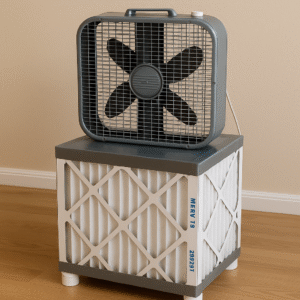DIY Air Filtration: How to Protect Your Home from Wildfire Smoke
When wildfire smoke fills the air — like what we’ve seen recently from the Monroe Canyon Fire — indoor air quality can decline fast. Even if you stay indoors, fine smoke particles can still find their way inside, putting your family’s health at risk. Fortunately, there are simple and affordable DIY ways to boost your home’s air filtration using tools you may already have.
In this post, we’ll walk you through two easy homemade air purifier builds — one basic and one upgraded — that can significantly reduce particulate matter indoors. These projects use common items like a box fan and MERV 13 filters to help keep your air cleaner, your lungs happier, and your home safer.
TL;DR — Quick Summary
-
Check your HVAC system first. Use a 4-inch high-efficiency filter and set your fan to “ON” for continuous circulation.
-
Start simple: Tape a MERV 13 filter to the back of a 20-inch box fan to create a quick, effective purifier.
-
Upgrade your design: Build a cube using multiple MERV 13 filters and mount the fan on top for greater airflow and longer filter life.
-
Change filters often: Smoke particulates clog filters quickly — inspect and replace them every few weeks during wildfire season.
-
Consider extra protection: Devices like the Reme Halo air sanitizer can help neutralize odors and airborne contaminants.
Why Indoor Air Filtration Matters During Wildfires
When wildfires burn, they release tiny particles known as PM2.5 — microscopic pollutants that can penetrate deep into your lungs. Even short-term exposure can worsen asthma, allergies, and respiratory symptoms, especially for children, seniors, and anyone with heart or lung conditions.
Utah’s valleys tend to trap smoke, worsening local air quality. Even if you can’t smell smoke indoors, it’s still likely present. That’s why it’s vital to take proactive steps — improving your filtration is one of the simplest and most effective ways to do that.
Step 1: Strengthen Your Home HVAC Filtration
Before diving into DIY builds, start with your home’s main HVAC system:
-
Use a 4-inch pleated air filter rated MERV 13 or higher.
-
Set your system’s fan to “ON” (not “AUTO”) — this ensures continuous air circulation through the filter.
-
Check filters every few weeks during smoke events. Dirty filters reduce airflow, stress your system, and allow pollutants to circulate.
If you’re unsure how to do this, our partners at At Your Service Pros can walk you through setting up your HVAC system for optimal air quality.
For extra odor and germ protection, consider upgrading to an in-duct air purifier like the Reme Halo, which uses ionized hydroperoxides to neutralize contaminants before they spread through your home.

Step 2: Build a Basic DIY Box Fan Air Filter
What You’ll Need
-
One 20-inch box fan ($20–$25)
-
One MERV 13 filter, 20″x20″x4″
-
Tape (duct tape, painter’s tape, or weather-sealing tape)
How to Build It
-
Place the air filter on the intake side of the fan (the back).
-
Ensure the arrow on the filter points toward the fan.
-
Tape around all edges to create a tight seal so air doesn’t leak around the filter.
-
(Optional) Use cardboard pieces to cover the corners — this increases airflow through the center and improves efficiency.
How It Works
The fan draws smoky air through the MERV 13 filter, trapping fine particles before blowing clean air back into your space.
You can place this setup near your front door, bedroom, or any high-traffic area. It’s ideal for small rooms or short-term use but will require frequent filter changes during heavy smoke events.

Step 3: Upgrade to a Multi-Filter Cube for Better Airflow
If you want a more powerful and longer-lasting setup, try the five-filter cube design.
What You’ll Need
-
Five MERV 13 filters (20″x20″x4″)
-
One 20-inch box fan (metal housing preferred)
-
Tape
-
Four small PVC couplers or blocks (to elevate the cube off the floor)
Build Instructions
-
Form a cube: Tape four filters together to form the sides, ensuring the arrows point inward.
-
Add the base: Tape the fifth filter to the bottom.
-
Seal all edges with tape to prevent air leaks.
-
Place the fan on top of the cube, facing upward.
-
Use tape or foam to create a tight seal between the fan and filters.
-
Elevate the cube slightly using PVC couplers so it can draw air from underneath.
Why This Works Better
By increasing the filter surface area, you reduce resistance and extend filter life. The cube design pulls air evenly from all sides, allowing for higher airflow and more efficient filtration — ideal for large rooms or homes closer to active fires.
You can let this run continuously on low or medium fan speed to maintain cleaner indoor air 24/7.
Step 4: Maintenance and Filter Replacement
-
Inspect weekly during wildfire season. If your filter looks gray or bent, replace it immediately.
-
Vacuum around the setup regularly to prevent dust buildup.
-
Keep pets and small children away from exposed fans for safety.
-
Never leave running unattended overnight unless you’re confident in your setup’s stability.
For homeowners in Utah, Healthy Water and Air can provide bulk MERV 13 filters by the case at cost, with local will-call options in Salt Lake County. Contact us for availability.
Key Takeaway
Wildfire smoke doesn’t have to take over your indoor air. With just a fan, a few filters, and some tape, you can dramatically reduce your exposure to harmful particulates. For ongoing protection, maintain your HVAC filter, run your fan constantly, and consider adding an air purifier like the Reme Halo for next-level air sanitation.

